References
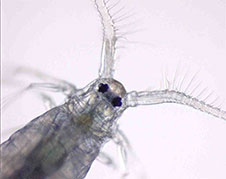
Ajani, P., Hallegraeff, G.M. and Pritchard, T. (2001). Historic overview of algal blooms in marine and estuarine waters of New South Wales, Australia. Proceedings of the Linnean Society of NSW 123: 1-22.
Alldredge, A. (1972). Abandoned larvacean houses: a unique food source in the pelagic environment. Science 177: 885-887.
Andronov, V.N. (2001). On the taxonomy of the genus Nannocalanus Sars, 1925 (Crustacea, Copepoda: Calanidae). Zoosystematica Rossica 9(2): 277-283.
Ara, K. (2002). Temporal variability and production of Temora turbinata (Copepoda : Calanoida) in the Cananeia Lagoon estuarine system, Sao Paulo, Brazil. Scientia Marina 66: 399-406.
Ashjian, C.J. and Wishner, K.F. (1993). Temporal and spatial changes in body size and reproductive state of Nannocalanus minor (Copepoda) females across and along the Gulf Stream. Journal of Plankton Research 15: 67-98.
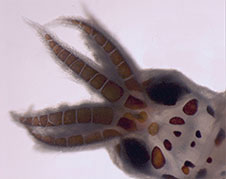
Boltovskoy, D. (ed.) (1999). South Atlantic Zooplankton: Backhuys Publishers, Leiden, the Netherlands.
Boxshall, G. A. And Halsey, S. A. (2004). An Introduction to copepod diversity. Henry Ling Ltd, The Dorset Press, Dorchester.
Bradford, J. (1976). Partial revision of the Acartia subgenus Acartiura (Copepoda: Calanoida: Acartiidae). New Zealand Journal of Marine and Freshwater Research 10: 159-202.
Bradford-Grieve, J. M. (1994). The marine fauna of New Zealand: Pelagic Copepoda: Megacalanidae, Calanidae, Paracalanidae, Mecynoceridae, Eucalanidae, Spinocalanidae, Clausocalanidae. National Institute of Water and Atmospheric Research, Wellington, New Zealand.
Bradford-Grieve, J. (1999). The marine fauna of New Zealand: Pelagic Copepoda: Arietellidae, Augaptilidae, Heterorhabdidae, Lucicutiidae, Metridinidae, Phyllopodidae, Centropagiidae, Pseudodiaptomidae, Temoridae, Candaciidae, Pontellidae, Sulcanidae, Acartiidae, Tortanidae. NIWA Biodiversity Memoirs 111, 268 pp.
Bruce, B.D., Sutton, C.A. and Lyne, V. (1995). Laboratory and field studies of the larval distribution and duration of the introduced seastar Asterias amurensis with updated and improved prediction of the species spread based on a larval dispersal model. Final Report Fisheries Research and Development Corporation No. 93/235. Deakin, ACT, Australia.
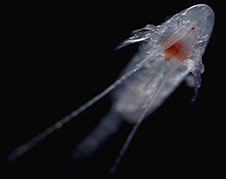
Brusca, R. C. and Brusca, G. J. (1990). Invertebrates. Sinauer Associates. Sunderland. MA.
Bucklin, A., LaJeunesse, TC., Curry, E., Wallinga, J., and Garrison, K. (1996). Molecular diversity of the copepod, Nannocalanus minor: genetic evidence of species and population structure in the North Atlantic Ocean. Journal of Marine Research 54: 285-310.
Conway DVP, White, R.G., Hugues-Dit-Ciles, J., Gallienne, C.P. and Robins, D.B. (2003). Guide to the coastal and surface zooplankton of the south-western Indian Ocean, Vol Occasional Publications No. 15. Marine Biological Association of the United Kingdom.
Corral Estrada, J., (1970). In Thesis Doct., Univ. Madrid, A-129, Sec. Biologicas.
Daan, R. (1989). Factors controlling the summer development of copepod in the Southern Bight of the North Sea. Netherland Journal of Sea Research 23: 305-322.
Dakin, W.J. and Colefax, A.N. (1933). The marine plankton of the coastal waters of New South Wales. 1. the chief planktonic forms and their seasonal distribution. Proceedings of the Linnean Society of NSW 58: 186-222.
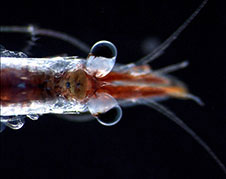
Dakin, W.J. and Colefax, A.N. (1940). The plankton of the Australian coastal waters off New South Wales Part 1. University of Sydney Monograph No. 1. 215pp.
Enomoto, Y. (1956). On the occurrence and the food of Noctiluca scintillans (Macartney) in the waters adjacent to the west coast of Kyushu, with the special reference of a possibility of the damage caused to the fish eggs by that plankton. Bulletin of the Japanese Society of Science and Fisheries 22: 82-88.
Farran, G.P. (1929). Crustacea. Part X. Copepoda. Natural History Report British Antarctic Terra Nova Expedition 8: 203-306.
Fernández de Puelles, M. L., Lopéz-Urrutia, Á., Morillas, A. & Molinero, J. C. 2009. Seasonal variability of copepod abundance in the Balearic region (Western Mediterranean) as an indicator of basin scale hydrological changes. Hydrobiologia, 617, 3-16.
Fincham, A.A. (1984). Basic Marine Biology. British Museum (Natural History) and Cambridge University press, Cambridge, 157pp.
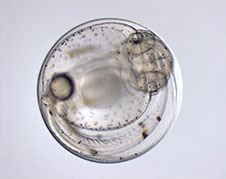
Fock, H.O. and Greve, W.C. (2002). Analysis and interpretation of recurrent spatio-temporal patterns in zooplankton dynamics: a case study on Noctiluca scintillans (Dinophyceae) in the German Bight (North Sea). Marine Biology 140: 59-73.
Gibbons, M.J. (1997). An introduction to the zooplankton of the Benguela Current region. 4pp. Ocean Docs (eRespository of Ocean Publications).
Heron, A.C. (1972). Population ecology of a colonizing species: the pelagic tunicate Thalia democratica I. Individual growth rate and generation time. Oecologia 10: 269-293
Hsiao, S. H., KÂ, S., Fang, T. H. & Hwang, J. S. (2011). Zooplankton assemblages as indicators of seasonal changes in water masses in the boundary waters between the East China Sea and the Taiwan Strait. Hydrobiologia, 666, 317-330.
Huang, W. and Qi, Y. (1997). The abundance cycle and influence factors on red tide phenomena of Noctiluca scintillans (Dinophyceae) in Dapeng Bay, South China Sea. Journal of Plankton Research 19: 303-318.
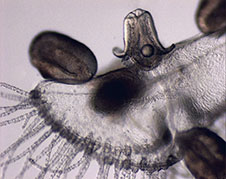
Kimmerer, W.J. and McKinnon, A.D. (1985). A comparative study of the zooplankton in two adjacent embayments, Port Phillip and Westernport Bays, Australia. Estuarine, Coastal and Shelf Science 21: 145-159.
Kimmerer, W.J. and McKinnon, A.D. (1987). Zooplankton in a marine bay. III. Evidence for influence of vertebrate predation on distributions of two common copepods. Marine Ecology Progress Series 53: 21-35.
Larink, O. and Westheide, W. (2006). Coastal plankton, photo guide for european seas. Verlag Dr. Friedrich Pfiel, Germany.
Lehto, J., Sulkin, A., Strom, S. and Johnson, D. (1998). Protists and detrical particles as prey for the first larval stage of the brachyuran crab: Hemigrapsus oregonensis. Journal of Experimental Marine
Biology and Ecology 230: 213-224.
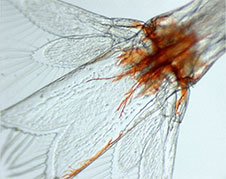
Lucas, I.A.N. (1982). Observations on Noctiluca scintillans Macartney (Ehrenb.) (Dinophyceae) with notes on an intracellular bacterium. Journal of Plankton Research 4: 401-409.
McKinnon, A.D., Kimmerer, W.J. and Benzie, J.A.H. (1992). Sympatric sibling species within the genus Acartia (Copepoda : Calanoida): a case study from Westernport and Port Phillip Bays. Journal of Crustacean Biology 12: 239-259.
Mauchline, J. (1998). The biology of calanoid copepods. Advances in Marine Biology Volume:33, Pages: i-x, 1-701.
Nakamura, Y. (1998). Biomass, feeding and production of Noctiluca scintillans in the Seto Inland Sea, Japan. Journal of Plankton Research 20: 2213-2222.
Ohtsudo, S. and Kubo, N. (1991). Larvaceans and their houses as important food for some pelagic copepods. Proceedings of the 4th international conference on copepods : Bulletin of the Plankton Society of Japan, Special volume 1991: 535-551.
Ong J.E. (1970). Ultrastructural studies of the cephalosome of some marine and estuarine calanoid copepods. Ph.D. thesis University of Tasmania.
O'Sullivan, D. (1982). Guide to the Scyphomedusae of the Southern Ocean and adjacent waters. ANARE Research Notes No. 4. Australian Antarctic Division.
O'Sullivan, D. (1982). Guide to the Hydromedusae of the Southern Ocean and adjacent waters. ANARE Research Notes No. 5. Australian Antarctic Division.
O'Sullivan, D. and Hosie, G.W. (1985). A general guide to the metazoan zooplankton groups of the Southern Ocean. ANARE Research Notes No. 30. Australian Antarctic Division.
Pratje, A. (1925). Noctiluca. In : Grimpe, J Wagler E (Eds) Die Tierwelt der Nord- und Ostsee. Akademische Verlagsanstalt, Leipzig 1-12.
Quevedo, M., Gonzalez-Quiros, R. and Anadon, R. (1999). Evidence of heavy predation by Noctiluca scintillans on Acartia clausi (Copepoda) eggs off the central Cantabrian coast (NW Spain). Oceanologica Acta 22: 127-131.
Rakhesh, M., Raman, A. V. & Sudarsan, D. 2006. Discriminating zooplankton assemblages in neritic and oceanic waters: A case for the northeast coast of India, Bay of Bengal. Marine Environmental Research, 61, 93-109.
Razouls C., de Bovée F., Kouwenberg J. et Desreumaux N., 2005-2012. - Diversity and Geographic Distribution of Marine Planktonic Copepods. Available at http://copepodes.obs-banyuls.fr/en
Sabatini, M.E., Ramirez, F.C. and Martos, P. (2000). Distribution pattern and population structure of Calanus australis Brodsky, 1959 over the southern Patagonian Shelf off Argentina in summer. ICES Journal of Marine Science 57: 1856-1866.
Sazhina, L.I. (1996). Fecundity of the Black Sea copepods in 1992. Oceanology 35 : 516-522.
Sulkin, S., Lehto, J., Strom, S. and Hutchinson, D. (1998). Nutritional role of protists in the diet of the first stage larvae of the Dungeness crab Cancer magister. Marine Ecology Progress Series 169: 237-242.
Sutton, C. and Green, M. (1999). Staging guide for the larvae of the Northern Pacific seastar Asterias amurensis. Centre for Research on Introduced Marine Pests, CSIRO, Technical report No. 19. 30pp.
Swadling, K.M. and Bayly I.A.E. (1997). Different zooplankton communities in confluent waters: comparisons between three marine bays in Victoria, Australia. Proceedings of the Royal Society of Victoria 109: 113-118.
Taw, N. (1975). Zooplankton and hydrology of the south east coastal waters of Tasmania. Ph.D. thesis University of Tasmania, Australia.
Taw, N. (1978). Some common components of the zooplankton of the southeastern coastal waters of Tasmania. Papers and Proceedings of the Royal Society of Tasmania 112: 69-136.
Taw, N. & Ritz, D. (1979). Influence of Subantartic and Subtropical Oceanic Water on the Zooplankton and Hydrology of Waters Adjacent to the Derwent River Estuary, South-eastern Tasmania. Marine and Freshwater Research, 30, 179-202.
Thomas, L.P. (1979). Red waters at Lysekil. Sea Frontiers 25: 229-233.
Tiselius, P. and Kiorboe, T. (1998). Colonization of diatoms aggregates by the dinoflagellate, Noctiluca scintillans. Limnology and Oceanography 43: 154-159.
Turner, J. T. (1984). Zooplankton feeding ecology: contents of fecal pellets of the copepods Temora turbinata and T. stylifera from continental shelf and slope waters near the mouth of the Mississippi River. Marine Biology, 82, 73-83.
Turner, J.T. (1986). Zooplankton feeding ecology: content of fecal pellets of the copepod Acartia tonsa and Labidocera aestiva from the continental shelf and slope waters near the mouth of the Mississippi River. Marine Ecology 5: 265-282.
Vervoort, W. (1957). Copepods from Antarctic and sub-Antarctic plankton samples. Report from the British, Australian and New Zealand Antarctic Research Expedition 3: 1-160.
Vervoort, W. (1964). Notes on two Pacific species of Centropages (Copepoda, Calanoida), C. australiensis Fairbridge, 1944, and C. aucklandicus Kramer, 1895. Crustaceana 7: 293-311

